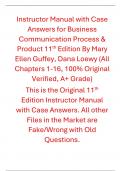Instructor Manual with Case
Answers for Business
Communication Process &
Product 11 Edition By Mary
th
Ellen Guffey, Dana Loewy (All
Chapters 1-16, 100% Original
Verified, A+ Grade)
This is the Original 11th
Edition Instructor Manual
with Case Answers. All other
Files in the Market are
Fake/Wrong with Old
Questions.
, Instructor Manual: Guffey/Loewy, Business Communication, Process & Product, 11e, 978-0-357-98410-9; Chapter 1:
Business Communication in the Digital Age
Instructor Manual
Guffey/Loewy, Business Communication, Process & Product, 11e, 978-0-357-98410-9;
Chapter 1: Business Communication in the Digital Age
TABLE OF CONTENTS
Purpose and Perspective of the Chapter ........................................................................... 2
Learning Outcomes ............................................................................................................... 2
What's New in This Chapter ................................................................................................ 2
Chapter Outline ..................................................................................................................... 3
Additional Discussion Questions ....................................................................................... 10
Case Study ............................................................................................................................ 12
End of Chapter Answer Keys .............................................................................................. 15
Critical Thinking ............................................................................................................................ 15
Activities........................................................................................................................................ 16
Test Your Workplace Etiquette Awareness .........................................................................26
Chat About It ........................................................................................................................ 27
Appendix .............................................................................................................................. 28
Generic Rubrics ...........................................................................................................................28
Standard Discussion Rubric ........................................................................................................29
© 2025 Cengage Learning, Inc. All Rights Reserved. May not be scanned, copied or
duplicated, or posted to a publicly accessible website, in whole or in part. 1
, Instructor Manual: Guffey/Loewy, Business Communication, Process & Product, 11e, 978-0-357-98410-9; Chapter 1:
Business Communication in the Digital Age
PURPOSE AND PERSPECTIVE OF THE CHAPTER
The purpose of this chapter is to provide students with an overview of business communication
in the digital age. First, we explain how communication and critical thinking skills fuel career
success in a digital, mobile, and social workplace. Next, we emphasize the importance of
building recession-proof and future-ready skills, exploring the creative problem-solving process,
the dangers of disinformation, and the skills that employers seek. Then, we explore the trends
and challenges in the information age workplace. We look at significant workplace changes
including a sharing economy, work-life balance, global competition, shrinking management
layers, and an increased use of teams. We also explore technology-enabled remote work and
how these flexible work environments and a diverse workforce are creating dramatic changes in
how and where we work today. Additionally, we explain how to compare and contrast internal
and external functions of communication, formal and informal forms of communication, and oral
and written communication. Finally, we identify the goals of ethical business communicators and
provide practical guidelines for making ethical decisions and addressing wrongdoing in the
workplace.
LEARNING OUTCOMES
The following outcomes are addressed in this chapter:
1.1 Describe how communication skills can fuel career success in an uncertain world of
work.
1.2 Identify the powerful interpersonal traits and capabilities that are considered twenty-
first-century skills.
1.3 List significant trends affecting business communication in today’s information age
workplace.
1.4 Describe communication channels in organizations and their media richness.
1.5 Explain the importance of being an ethical business communicator.
WHAT'S NEW IN THIS CHAPTER
The following elements are improvements in this chapter from the previous edition:
• To familiarize students with current workplace trends, prepared a timely and relevant new
opening case addressing companies that have adopted the four-day workweek.
• Rewrote substantial sections of the chapter to reflect the pervasive influence of
transformational technologies shaping business today and prepare students for the age of
AI and automation.
© 2025 Cengage Learning, Inc. All Rights Reserved. May not be scanned, copied or
duplicated, or posted to a publicly accessible website, in whole or in part. 2
, Instructor Manual: Guffey/Loewy, Business Communication, Process & Product, 11e, 978-0-357-98410-9; Chapter 1:
Business Communication in the Digital Age
• Presented state-of-the-art research showing the importance of communication and other
interpersonal skills in a job market that will require that humans collaborate with and
complement AI tools.
• Emphasized the need for critical thinking in the age of automation along with discernment in
the face of disinformation, deep fakes, and other threats to business, society, and
democracy itself.
• Boosted the coverage of technology-enabled remote work, whether executed by people with
hybrid schedules or by digital nomads, to preview a future that will demand superior
communication skills.
• Devoted much attention to disruptive technologies—particularly AI and ChatGPT—and the
changing nature of post-pandemic work (The Great Resignation, quiet quitting) to expose
students to significant workplace trends.
• Introduced hot-button topics such as DEI and ESG, both efforts to achieve greater equity
and inclusion, as well as protect the environment and improve governance in the workplace
of the future.
• Updated the coverage of ethics, introducing the latest examples of corporate malfeasance
and showing that Americans want change and are less inclined to overlook executives’
ethical lapses.
• Created relevant, pedagogically sound end-of-chapter activities, some of which feature
tasks to be completed with the help of ChatGPT and show how students can use this AI tool
effectively.
[return to top]
CHAPTER OUTLINE
In the outline below, each element includes references (in parentheses) to related content. “L.O”
refers to the chapter learning outcome and “PPT Slide #” refers to the slide number in the
PowerPoint deck for this chapter (provided in the PowerPoints section of the Instructor
Resource Center). Introduce the chapter and review learning outcomes for Chapter 1. (PPT
Slides 1-2).
I. Thriving in an Ever-Changing Workplace With Communication Skills (L.O. 1.1, PPT Slides
3–7, DISC: Purpose; Communication evolution)
a. At a time of unprecedented economic, political, and technological change, future-proof
occupations require communication, creativity, and specialized knowledge.
b. Soft skills/emotional intelligence – powerful social and interpersonal skills
c. Interpersonal skills/professional skills – a combination of communication, critical
thinking, dependability, and time management skills
d. This important skill set is most likely to protect workers from being replaced by
machines in the age of automation.
© 2025 Cengage Learning, Inc. All Rights Reserved. May not be scanned, copied or
duplicated, or posted to a publicly accessible website, in whole or in part. 3




